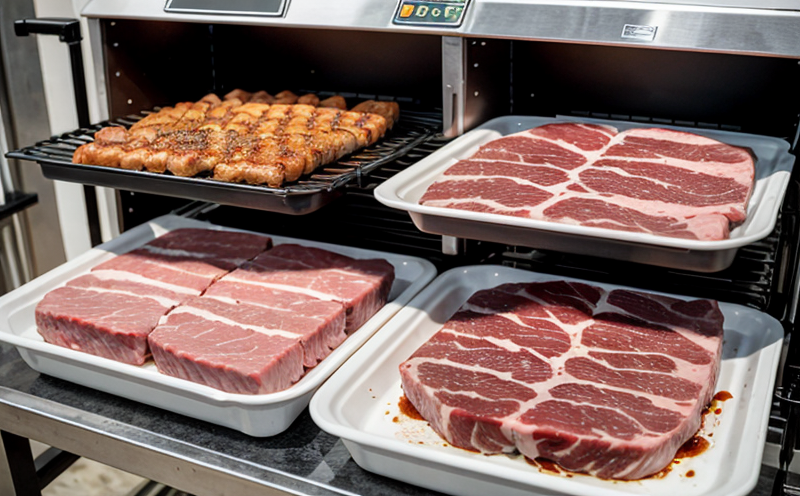ISO 52820 Texture and Consistency Analysis in Poultry Meat
The ISO 52820 standard provides a comprehensive framework for texture and consistency analysis of poultry meat, focusing on the physical characteristics that influence consumer satisfaction. This service is particularly valuable for food manufacturers, quality managers, compliance officers, and R&D engineers who need to ensure product consistency across batches.
Texture and consistency are critical attributes in poultry meat products as they directly impact sensory qualities such as chewiness, juiciness, and overall eating experience. These factors can be influenced by various processing conditions including temperature during cooking, storage time, packaging methods, and the type of additives used.
The ISO 52820 protocol specifies detailed procedures for preparing samples, using a texture analyzer to measure texture parameters like hardness, springiness, cohesiveness, gumminess, and chewiness. The test involves subjecting small portions of cooked or processed poultry meat to controlled deformation under specified loads and speeds.
For accurate results, it is essential to follow the standard closely. Sample preparation must be uniform in size and shape; deviations can lead to inconsistent measurements. After preparing samples according to ISO 52820, they are placed into the texture analyzer for testing. The machine applies a known force over time while monitoring deformation.
The data collected from these tests provides insights into how changes in processing conditions affect product quality. This information is invaluable for optimizing production processes and maintaining consistent product quality across batches.
By adhering to ISO 52820, laboratories can ensure that their testing methods are reliable and reproducible. This standardization enhances trust between suppliers and buyers, ensuring that products meet specified criteria and satisfy regulatory requirements.
The service offered by our laboratory goes beyond simple compliance; it aims at continuous improvement in product quality. Our team of experts works closely with clients to identify specific areas where texture and consistency can be improved based on the results obtained from ISO 52820 testing.
Understanding consumer preferences plays a significant role in refining products. By leveraging ISO 52820 data, companies can tailor their offerings more precisely to meet market demands. This approach not only improves customer satisfaction but also enhances brand reputation and loyalty.
In conclusion, implementing ISO 52820 texture and consistency analysis is crucial for maintaining high standards in poultry meat products. It provides a scientific basis for assessing product quality, which is essential for both regulatory compliance and competitive advantage.
Industry Applications
The application of ISO 52820 texture and consistency analysis extends across various segments within the food industry:
- Poultry Processing Plants: Ensuring consistent product quality throughout different stages of production.
- Retailers: Offering customers products with uniform texture and consistency, enhancing customer satisfaction.
- Distributors: Maintaining quality standards during transportation and storage to prevent degradation.
- Research & Development: Developing new products or improving existing ones based on consumer feedback and market trends.
These applications highlight the importance of texture and consistency in maintaining brand reputation and customer trust. By adhering to ISO 52820, businesses can ensure that their products consistently meet expected quality levels.
Customer Impact and Satisfaction
Implementing ISO 52820 texture and consistency analysis has several positive impacts on customers:
- Better Product Quality: Consistent product quality ensures that every purchase meets the expected standards.
- Enhanced Reputation: Maintaining high-quality products improves brand image, leading to increased customer loyalty.
- Increased Satisfaction: Customers are more likely to return for repeat purchases when they consistently receive satisfactory products.
- Better Decision-Making: Data-driven insights help businesses make informed decisions about product development and marketing strategies.
The benefits extend beyond just the immediate customers. By ensuring consistent quality, companies also build trust with their supply chain partners and other stakeholders.
International Acceptance and Recognition
ISO 52820 texture and consistency analysis is widely recognized internationally for its role in standardizing poultry meat testing:
- Regulatory Compliance: Many countries have adopted ISO standards as part of their regulatory frameworks.
- Global Trade: Consistent quality measurement facilitates smoother international trade, reducing disputes over product specifications.
- Industry Standards: Adherence to these standards ensures that products meet global expectations and are accepted in diverse markets.
The acceptance of ISO 52820 within the industry underscores its importance. Laboratories that offer this service contribute significantly to maintaining international quality benchmarks.





